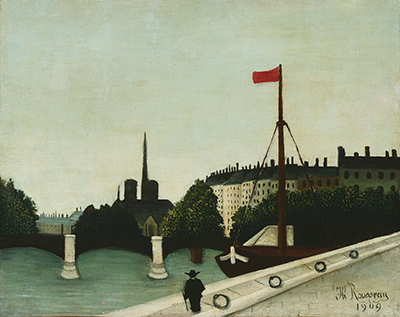The Notre Dame is an oil canvas painting created by French impressionist painter Henri Rousseau ca. 1909. The Notre Dame canvas painting measures nearly 12 6/8 x 16 2/8 in.; 32.7125 x 40.9675 cm. Its current location is at the Philips Collection, Washington D.C., USA.
The Notre Dame by Henri Rousseau appears to have celebrated his viewpoint of himself as a professional artist, as well as his allegiance and love for the city of Paris. He included a solitary and black-attired figure with a walking stick, which may have been created as a miniature image of himself. The Notre Dame conveys an ambience of quiet sentimentality - the spire of Sainte-Chapelle and the towers of Notre Dame, generated within a soft, ghostly light, which seems to hold the fascinated attention of the lonely male figure. The uncomplicated structure and the natural colours are characteristic subtleties of Rousseau's work.
Henri Rousseau was a post-impressionist painter, yet he was initially identified as 'Le Douanier' (or the 'customs officer'), a humorous depiction of his profession as a tax and toll collector at the time. He commenced painting earnestly while in his forties, and by the age of 48, he retired from this profession to work on his painting fulltime. He was often ridiculed during his lifetime by notable critics, and he eventually came to be recognised as a self-taught genius whose works are of high artistic quality.
Rousseau would attempt different painting styles when he painted fulltime, but would always return to this theme throughout his career, painting from specific vantage points where he could capture the scene's character but in varying styles. In this piece, he presented all the compositional details in the same relaxed brushwork and colour scheme. Here, he unifies the bridge over the River Seine, with the façade of the Notre Dame Cathedral.
The Notre Dame may have been inspired by photographic images and an associated handwritten design that Rousseau had previously made. However, it was also speculated that he seemingly relied on his recollections of numerous years sauntering and working on the docks of Paris's rivers - clarifying the scene through his imaginative vision and thus instilling the eventual design with a characteristically timeless atmosphere. One art critic who admired Rousseau's work, described the paintings' ambience as one of "peaceful unhappiness in which the barge' mast, and the steeple of Notre Dame, appear to 'talk' to each other across the river." See also Notre-Dame, une Fin d'Apres-Midi, Notre Dame and View of Notre-Dame by Henri Matisse.




